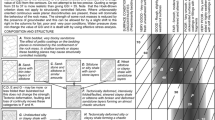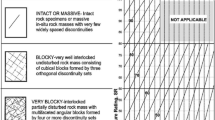Abstract
This paper describes an application of the geological strength index (GSI) method to the San Mauro formation, which is characterized by sandstones alternating with argillaceous marls. The Sandstone/Pelite (S/P) ratio and structural complexity were determined. Geo-structural and geo-mechanical surveys were undertaken in situ and rock samples were tested in the laboratory. A map of the S/P ratio was produced showing the bedrock divided in four classes. Three ranges of GSI values were identified. The values of the intact UCS and of the constant m i were appropriately reduced to reflect the variable presence of sandstone compared with the pelitic fraction. A “weighted average” of the intact strength properties of the hard and weak layers was adopted. The values for the intact materials were reduced from 20 to 60% depending on the GSI categories of the heterogeneous rock mass. In this way, seven classes of rock masses characterized by different values of GSI, reduced UCS and m i values were identified.
Résumé
Cet article décrit l’application de la méthode GSI à la formation flyschoïde de San Mauro, dans le Cilento (Italie du Sud). Cette formation se caractérise par la présence de roches arénacées en alternance avec des bancs de marnes argileuses. Le rapport grès-pélite et la complexité structurale ont été examinés avec attention. Des travaux de recherche détaillés en géologie structurale et géomécanique ont été réalisés de même que des analyses au laboratoire de nombreux échantillons de roches. Une carte du rapport grès-pélite et été établie, représentant le substratum suivant quatre classes. Trois gammes de valeurs de GSI ont été identifiées. Les valeurs de résistance à la compression uniaxiale (UCS) et la constante m i ont été opportunément réduites pour refléter la proportion variable de grès par rapport à la fraction pélitique. Pour cette raison, une « moyenne pondérée » des propriétés géomécaniques des niveaux durs et tendres a été introduite. Les valeurs relatives aux matériaux intacts ont été réduites de 20 à 60% en fonction des valeurs de GSI des masses rocheuses hétérogènes. Ainsi, sept classes de massif rocheux, caractérisées par différentes valeurs de GSI, et des valeurs réduites de UCS et de m i ont été déterminées.









Similar content being viewed by others

References
AGI (1979) Some Italian experiences on the mechanical characterization of structurally complex formations. In: Proceedings of the 4th international congress ISRM, vol 1, pp 827–846
Bieniawski ZT (1975) The point load test in geotechnical practice. Eng Geol 9:1–11
Bonardi G, Amore FO, Ciampo G, De Capoa P, Miconnet P, Perrone V (1988) Il complesso liguride Auct.: stato delle conoscenze e problemi aperti sulla sua evoluzione pre-appenninica ed i suoi rapporti con l’Arco Calabro. Mem Soc Geol It 41:17–35 (in Italian)
Bonardi G, Ciarcia S, Di Nocera S, Matano F, Sgrosso I, Torre M (2009) Carta delle principali unità cinematiche dell’Appennino meridionale. Nota illustrative. It J Geosci 128(1):47–60
Broch E, Franklin JA (1972) The point load strength test. Int J Rock Mech Min Sci 9:669–697
Buljan R, Pollak D, Pest D (2006) Engineering geological properties of the rock mass along the Kastela Bay sewage system. In: Proceedings of the international symposium of the IAEG. Geological Society of London, vol 740, pp 467–477
D’Elia B, Esu F, Federico G, Tancredi G (1985) Geotechnical properties and slope stability in structurally complex clay soils. AGI Golden Jubilee Volume, pp 215–224
Dazzaro L, Di Nocera S, Pescatore T, Rapisardi L, Romeo M, Russo B, Senatore M, Torre M (1988) Geologia del margine della catena appenninica tra il F. Fortore ed il T. Calaggio (Monti della Daunia—App. Merid.). Mem Soc Geol It 41:411–422 (in Italian)
De Vita P (1999) Instabilità dei versanti e potenzialità idrica sotterranea dei rilievi arenaceo-pelitici del Vallone dell’Acquasanta (Bacino del Fiume Testene—Campania). Geologia Tecnica & Ambientale 7(4):47–54 (in Italian)
Esu F (1977) Behaviour of slopes in structurally complex formations. In: Proceedings of the international symposium on the geotechnics of structurally complex formations, pp 292–304
Hoek E, Brown ET (1997) Practical estimates or rock mass strength. Int J Rock Mech Min Sci Geomech Abstr 34(8):1165–1186
Hoek E, Marinos P, Benissi M (1998) Applicability of the geological strength index (GSI) classification for very weak and sheared rock masses. The case of the Athens Schist Formation. Bull Eng Geol Environ 57:151–160
Ietto A, Pescatore T, Cocco E (1965) Il flysch mesozoico-terziario del Cilento occidentale. Boll Soc Nat Napoli 74:396–402 (in Italian)
Mandrone G (2006) Engineering geological mapping of heterogeneous rock masses in the Northern Apennines: an example from the Parma Valley (Italy). Bull Eng Geol Environ 65:245–252
Marinos P, Hoek E (2001) Estimating the geotechnical properties of heterogeneous rock masses such as flysch. Bull Eng Geol Environ 61:85–92
Marinos V P, Aggistalis G, Kazilis N (2004) Engineering geological considerations in tunnelling through major tectonic thrust zones—cases along the Egnatia motorway, Northern Greece. In: Hack R, Azzam R, Charlier R (eds) LNES, vol 104. Springer, Berlin, pp 527–537
Medley E (1999) Systematic characterization of melange bimrocks and other chaotic soil/rock mixtures. Felsbau 17(3):152–162
Ogniben L (1969) Schema introduttivo alla geologia del confine calabro-lucano. Mem Soc Geol It 8(4):453–763 (in Italian)
Patacca E, Scandone P (1989) Post-Tortonian mountain building in the Apennines. The role of the passive sinking of a relict lithospheric slab. In: Boriani A, Bonafede M, Piccardo GB, Vai GB (eds) The lithosphere in Italy. Advances in earth science research. It Nat Comm Int Lith Prog, Mid-term Conf (Rome 5–6 May 1987) Atti Conv Lincei 80:157–176
Picarelli L, Olivares L (1998) Ingredients for modeling the mechanical behaviour of intensely fissured clay shales. In: Evangelista A, Picarelli L (eds) The geotechnics hard soils–soft rocks. Balkema, Rotterdam, pp 771–780
Rocscience inc (2002) ROCLAB Rock mass strength analysis using the generalized Hoek-Brown failure criterion, Toronto. http://www.rocscience.com
Ronchetti F, Borgatti L, Cervi F, Piccinini L, Alessandro Corsini A (2008) Modellazione numerica dei meccanismi di riattivazione di grandi frane per scivolamento di terra: l’esempio della frana di Tolara, Appennino Settentrionale. Giornale di Geologia Applicata 8(2):217–232
Rusnak J, Mark C (2000) Using the point load test to determine the uniaxial compressive strength of Coal Measure rock. In: Peng SS, Mark C (eds) Proceedings of the 19th international conference on ground control in mining. West Virginia University, Morgantown, pp 362–371
Scandone P (1967) Studi di geologia lucana: la serie calcareo-silico-marnosa e i suoi rapporti con l’Appennino calcareo. Boll Soc Nat in Napoli 76:1–175 (in Italian)
Scandone P (1972) Studi di geologia lucana: carta dei terreni della serie calcareo-silico-marnosa e note illustrative. Boll Soc Nat in Napoli 81:225–300 (in Italian)
Selli R (1957) Sulla trasgressione del Miocene nell’Italia meridionale. Giornale di Geologia 26(2):1–54 (in Italian)
Tsiambaosa G, Sabatakakis N (2004) Considerations on strength of intact sedimentary rocks. Eng Geol 72:261–273
Acknowledgments
The authors are grateful to D. Calcaterra for comments and suggestions that improved this paper. This work was carried out with financial contributions from the University of Naples “Federico II” under Prof. P. Budetta.
Author information
Authors and Affiliations
Corresponding author
Rights and permissions
About this article
Cite this article
Budetta, P., Nappi, M. Heterogeneous rock mass classification by means of the geological strength index: the San Mauro formation (Cilento, Italy). Bull Eng Geol Environ 70, 585–593 (2011). https://doi.org/10.1007/s10064-011-0351-1
Received:
Accepted:
Published:
Issue Date:
DOI: https://doi.org/10.1007/s10064-011-0351-1



